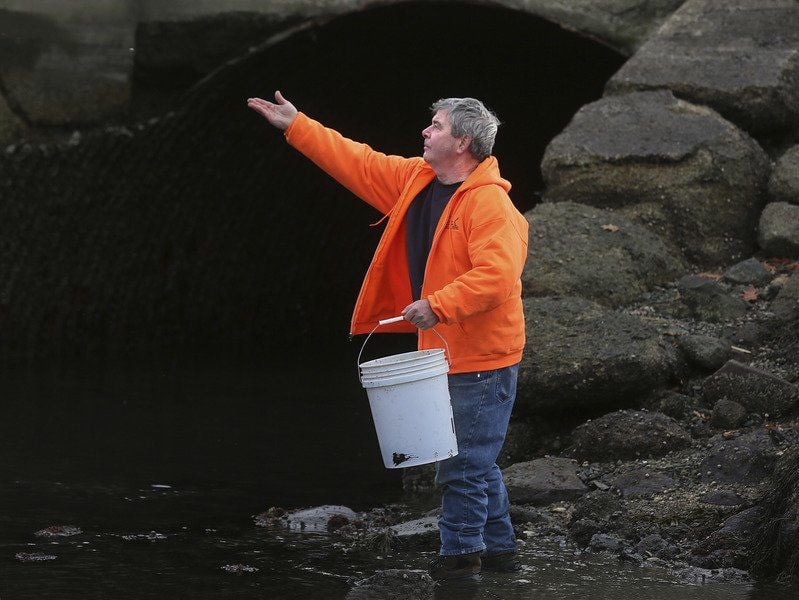There was a delightful write up in the Gloucester Times about the release of oysters raised in the upweller MOP operates with Maritime Gloucester. You can see the original article here.
We were pleased to see that this project helped us achieve our goals of getting more oysters in the water and education as thousands of people reached.

Mike Springer photo of Steve Parkes of Maritime Gloucester casting seed upon the waters.
The Massachusetts Oyster Project has successfully transferred about 60,000 juvenile oysters into estuaries in the waters off Essex, Gloucester and Ipswich to cap off its first season.
Now, it’s really up to the oysters.
“Obviously, we really want to keep an eye on them and make sure they do well,” said Jennifer Filliault of the Massachusetts Oyster Project. “It should take them a couple years to get to the standard size, which is about 3 inches.”
From July to November, the Massachusetts Oyster Project, in partnership with Maritime Gloucester, raised the oysters in a tank at the maritime education and museum on Harbor Loop. The tiny bivalves started off no bigger than a red-pepper flake and grew first to the size of a dime and then a nickel before being transferred into the wild.
“Maritime Gloucester was just a fantastic partner to work with,” Filliault said. “We had great survivability of the oysters and they became a real resource for educating students and visitors about oysters.”
She estimates more than 5,000 students and 20,000 Maritime Gloucester visitors visited the oyster tank and learned of the social and environmental benefits of oysters. The project provided aquaculture training to Maritime Gloucester interns, volunteers and staff.
The project also formed an alliance with Salem State University researchers to monitor the growth and survival of the oysters in the Essex location.
The oysters — standard Eastern oysters which are individually capable of filtering up to 50 gallons of water per day — now are the property of the individual communities, which will administer when and if they become part of the allocation annually reserved for public gathering.
But, according to Filliault, the oysters will have had the chance to go through several spawning seasons before they reach harvesting size, thus helping organically expand the population in the waters in which they reside.
“We’d like to see them stay in the water, spawn and multiply,” she said.
Filliault said plans for 2018 include working again with Maritime Gloucester on growing another batch of oysters in Gloucester, as well as seeking out other locations and partners on the North Shore or elsewhere to expand the stock of oysters available for transfer.
Contact Sean Horgan at 978-675-2714, or shorgan@gloucestertimes.com. Follow him on Twitter at @SeanGDT.

van cleef
ReplyDeletebape hoodie
louboutin shoes uk
chrome hearts online
dior glasses
adidas outlet online
nike polo
hermes belt
kyrie 4
yeezy shoes
hilfiger outlet
ReplyDeletejordan 3
rolex watches
nike store
nike air max
hilfiger uk
air force
adidas outlet store
supra shoes
montre homme
2018.5.19chenlixiang
ReplyDeleteEspecially superb!!! Exactly when I search for this I found this webpage at the top of every single online diary in web crawler.
Also visit my page ::: 대구오피
(jk)
Fatal Motorcycle Accident in Virginia Beach
ReplyDeleteThe Gloucester Times article on oyster restoration on the North Shore has received positive reviews, highlighting its importance in preserving local ecosystems. The article highlights the challenges and successes of oyster restoration, highlighting the hard work of conservationists. The North Shore's beautiful coastal areas are crucial for maintaining the health of these ecosystems, and the community's involvement in oyster restoration is a reminder of the power of collective action. The visually engaging photos accompanying the article bring the oyster restoration efforts to life, providing a well-rounded view of the ecological and economic benefits of oyster restoration. The Gloucester Times is praised for bringing attention to critical environmental issues, and the article is a story of hope and resilience. The article also highlights the positive environmental work happening in the community and the impact of small actions like oyster restoration on ocean health. The dedication of individuals and organizations involved in oyster restoration is inspiring, and readers look forward to more articles promoting awareness and action for the conservation of natural resources. However, these comments are fictional and may vary among readers and environmental enthusiasts.
"how to file for uncontested divorce in virginia"
ReplyDeleteThe Gloucester Times article on oyster restoration on the North Shore offers an insightful and engaging overview of the project, highlighting its environmental significance and community impact. The author captures the essence of the restoration project and its positive implications for the ecosystem and local communities, raising awareness about oyster conservation. The review includes quotes from individuals involved in the restoration efforts or those benefiting from the project, adding a personal touch. The article serves as an excellent introduction to the full content, enticing readers to explore the ongoing initiatives to enhance oyster populations on the North Shore.
The article on oyster restoration on the North Shore published in the Gloucester Times is rather interesting for me and, I suppose, important for people to know. To all the students help with assignment focusing on environmental science or marine ecology, this piece overviews useful field conservation strategies.
ReplyDeleteThe Gloucester Times article on oyster restoration highlights the importance of revitalizing North Shore ecosystems, and it’s fascinating how sustainability influences diverse industries, even beauty! For example, brazilian knot extensions are often seen as an eco-friendly hair solution, using sustainable human hair. This connection underscores a growing trend: valuing natural resources and responsible sourcing in all aspects of life.
ReplyDelete